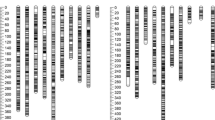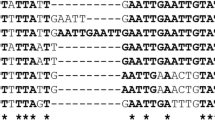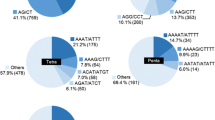Abstract
The Rosaceae contains many economically valuable crop genera, including Malus (apple), Fragaria (strawberry), and Prunus (stone fruit). There has been increasing interest in the development of linkage maps for these species, with a view to marker-assisted selection to assist breeding programs and, recently, in the development of transferable markers to permit syntenic comparisons of maps of different rosaceous genera. In this investigation, a set of Malus cDNA sequences were downloaded from the European Molecular Biology Laboratory database. The sequences were aligned with homologous full-length Arabidopsis genomic DNA sequences to identify putative intron–exon junctions and conserved flanking exon sequences. Primer pairs were designed from the conserved exon sequences flanking predicted intron–exon junctions in the Malus cDNA sequences. These were used to amplify products by polymerase chain reaction from the parents of the Malus mapping progeny “Fiesta” × “Totem.” Eleven loci, representing ten genes (39%), were polymorphic in the “Fiesta” × “Totem” population and mapped to seven Malus linkage groups. Transferability to other rosaceous genera was high, with primer pairs representing 85% of genes, amplifying products from Fragaria and primer pairs representing 85% of genes, amplifying products from Prunus genomic DNA. These primers were screened in the Fragaria and Prunus mapping bin sets and 38% of the genes were successfully located on both maps. Analysis of the markers mapped in more than one rosaceous genus revealed patterns of synteny between genera, while a comparison with the physical positions of homologous genes on the Arabidopsis genome revealed high sequence conservation but only fragmentary patterns of macrosynteny.



Similar content being viewed by others
References
Angiosperm Phylogeny Group (2003) An update of the Angiosperm Phylogeny Group classification for the orders and families of flowering plants: APG II.. Bot J Linn Soc 141:399–436
Ballester J, Bošković R, Batlle I, Arús P, Vargas F, de Vicente MC (1998) Location of the self-incompatibility gene on the almond linkage map. Plant Breeding 117:69–72
Bonierbale MW, Plaisted RL, Tanksley SD (1988) RFLP maps based on a common set of clones reveal modes of chromosomal evolution in potato and tomato. Genetics 120:1095–1103
Choi HK, Kim D, Uhm T, Limpens E, Lim H, Mun JH, Kalo P, Penmetsa RV, Seres A, Kulikova O, Roe BA, Bisseling T, Kiss GB, Cook DR (2004) A sequence-based genetic map of Medicago truncatula and comparison of marker collinearity with M-sativa. Genetics 166:1463–1502
Davis TM, Yu H (1997) A linkage map of the diploid strawberry, Fragaria vesca. J Hered 88:215–221
Devos KM, Gale MD (2000) Genome relationships: the grass model in current research. Plant Cell 12:637–646
Dirlewanger E, Graziano E, Joobeur T, Garriga-Calderé F, Cosson P, Howad W, Arús P (2004) Comparative mapping and marker-assisted selection in Rosaceae fruit crops. Proc Natl Acad Sci U S A 101:9891–9896
Doganlar S, Frary A, Daunay MC Lester RN, Tanksley SD (2002) A comparative genetic linkage map of eggplant (Solanum melongena) and its implications for genome evolution in the Solanaceae. Genetics 161:1697–1711
Dominguez I, Graziano E, Gebhardt C, Barakat A, Berry S, Arús P, Delseny M, Barnes S (2003) Plant genome archaeology: evidence for conserved ancestral chromosome segments in dicotyledonous plant species. Plant Biotech J 1:91–99
Fernández-Fernández F, Evans KM, Clarke JB, Govan CL, James CM, Marič S, Tobutt KR (2008) Development of an STS map of an interspecific progeny of Malus. Tree Genet Gen 4:469–479 doi:10.1007/s11295-007-0124-y
Fukatsu E, Isoda K, Hirao T, Takahashi M, Watanabe A (2005) Development and characterization of simple sequence repeat DNA markers for Zelkova serrata. Mol Ecol Notes 5:378–380
Georgi LL, Wang Y, Reighard GL, Mao L, Wing RA, Abbott AG (2003) Comparison of peach and Arabidopsis genomic sequences: fragmentary conservation of gene neighbourhoods. Genome 46:268–276
Howad W, Yamamoto T, Dirlewanger E, Testolin R, Cosson P, Cipriani G, Monforte AJ, Georgi L, Abbott AG, Arús P (2005) Mapping with a few plants: using selective mapping for microsatellite saturation of the Prunus reference map. Genetics 171:1305–1309
Illa E, Arús P, Dirlewanger E, Le Dantec L, Howad W (2007) ISAFRUIT: bin mapping of candidate genes involved in fruit quality of peach. In: 12th EUCARPIA symposium on fruit breeding and genetics, Zaragoza, Spain, P058
Jung S, Main D, Staton M, Cho I, Zhebentyayeva T, Arús P, Abbott A (2006) Synteny conservation between the Prunus genome and both the present and ancestral Arabidopsis genomes. BMC Genomics 7:81
Kaló P, Seres A, Taylor SA, Jakab J, Kevei Z, Kereszt A, Endre G, Ellis THN, Kiss GB (2004) Comparative mapping between Medicago sativa and Pisum sativum. Mol Genet Gen 272:235–246
Liebhard R, Gianfranceschi L, Koller B, Ryder CD, Tarchini R, Van de Weg E, Gessler C (2002) Development and characterisation of 140 new microsatellites in apple (Malus × domestica Borkh.). Mol Breeding 10:217–241
Lukens L, Zou F, Lydiate D, Parkin I, Osborn T (2003) Comparison of a Brassica oleracea genetic map with the genome of Arabidopsis thaliana. Genetics 164:359–372
Ma RC, Oliveira MM (2002) Evolutionary analysis of S-RNase genes from Rosaceae species. Mol Genet Gen 267:71–78
Maliepaard C, Alston FH, van Arkel G, Brown LM, Chevreau E, Dunemann F, Evans KM, Gardiner S, Guilford P, van Heusden AW, Janse J, Laurens F, Lynn JR, Manganaris AG, den Nijs APM, Periam N, Rikkerink E, Roche P, Ryder C, Sansavini S, Schmidt H, Tartarini S, Verhaegh JJ, Vrielink-van Ginkel M, King GJ (1998) Aligning male and female linkage maps of apple (Malus pumila Mill.) using multi-allelic markers. Theor Appl Genet 97:60–73
Nier S, Simpson DW, Tobutt KR, Sargent DJ (2006) Construction of a genetic linkage map of an interspecific diploid Fragaria BC1 mapping population (F. vesca 815 × [F. vesca 815 × F. viridis 903]) and its comparison to the Fragaria reference map (FVxFN). J Hortic Sci Biotech 81:645–650
Rhee SY, Beavis W, Berardini TZ, Chen GH, Dixon D, Doyle A, Garcia-Hernandez M, Huala E, Lander G, Montoya M, Miller N, Mueller LA, Mundodi S, Reiser L, Tacklind J, Weems DC, Wu YH, Xu I, Yoo D, Yoon J, Zhang PF (2003) The Arabidopsis Information Resource (TAIR): a model organism database providing a centralized, curated gateway to Arabidopsis biology, research materials and community. Nucleic Acids Res 31:224–228
Rozen S, Skaletsky HJ (1998) PRIMER 3. Code available at http://www-genome.wi.mit.edu/genome_software/other/primer3.html
Sargent DJ, Hadonou AM, Simpson DW (2003) Development and characterisation of polymorphic microsatellite markers from Fragaria viridis, a wild diploid strawberry. Mol Ecol Notes 3:550–552
Sargent DJ, Rys A, Nier S, Simpson DW, Tobutt KR (2007) The development and mapping of functional markers in Fragaria and their transferability and potential for mapping in other genera. Theor Appl Genet 114:373–384
Sargent DJ, Cipriani G, Vilanova S, Gil-Ariza D, Arús P, Simpson DW, Tobutt KR, Monfort A (2008) The development of a bin mapping population and the selective mapping of 103 markers in the diploid Fragaria reference mapping population FV×FN. Genome 51:120–127
Voorrips RE (2002) MapChart: software for the graphical presentation of linkage maps and QTLs. J Hered 93:77–78
Wei H, Fu Y, Arora R (2005) Intron-flanking EST–PCR markers: from genetic marker development to gene structure analysis in rhododendron. Theor Appl Genet 111:1347–1356
Yamamoto T, Kimura T, Saito T, Kotobuki K, Matsuta N, Liebhard R, Gessler C, van de Weg WE, Hayashi T (2004) Genetic linkage maps of Japanese and European pears aligned to the apple consensus map. Acta Hort 663:51–56
Acknowledgements
Rosaceous genomics at East Malling Research is funded by Defra through grant HH3724SSF (Comparative genomics of rosaceous fruit crops and HNS for sustainable production).
Author information
Authors and Affiliations
Corresponding author
Additional information
Communicated by A. Dandekar
Rights and permissions
About this article
Cite this article
Sargent, D.J., Marchese, A., Simpson, D.W. et al. Development of “universal” gene-specific markers from Malus spp. cDNA sequences, their mapping and use in synteny studies within Rosaceae. Tree Genetics & Genomes 5, 133–145 (2009). https://doi.org/10.1007/s11295-008-0178-5
Received:
Revised:
Accepted:
Published:
Issue Date:
DOI: https://doi.org/10.1007/s11295-008-0178-5




